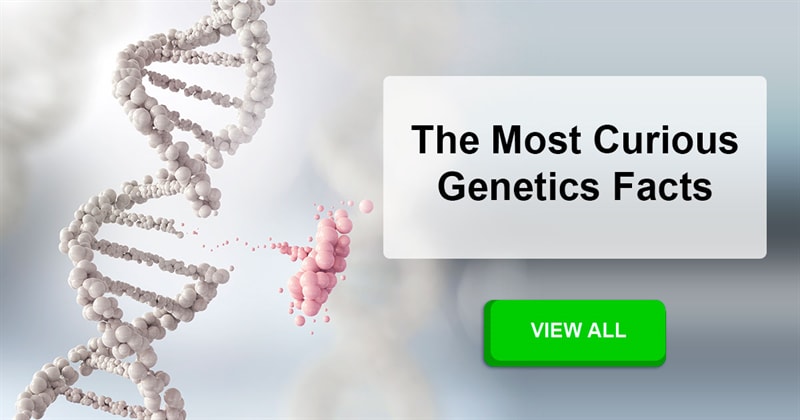What are some interesting facts about genetics?

1. When identical twins procreate with another set of identical twins, their offspring are both genetic siblings and social cousins.
2. Cheetahs were almost wiped out by the last ice-age, and all modern cheetahs are descended from a small portion of the surviving cats that interbred to maintain their species. Because of this, cheetahs are practically genetic clones of one another.
3. The great majority of cancers, some 90-95% of cases, are due to environmental factors. The remaining 5-10% are due to inherited genetics.
4. About 40% to 50% of the genetic information found in our GI tract does not match anything that has ever been classified before, not plant, animal, fungus, virus, or bacteria. We have no clue what it is. Biologists call it “biological dark matter.”
5. The “average” white American is 0.7% African by genetic descent, and that up to 30% of white Americans are between 2% and 20% African by genetic descent. Conversely, 10% of all black Americans are actually more than 50% European by genetic descent.
6. A species of fruit fly was kept in complete darkness for 57 years (1400 generations) showed genetic alterations that were favorable to survival in that environmental condition.
7. Some women can have a genetic mutation that makes them tetrachromatic, which causes their eyes to have four different types of cone cells, enabling them to see 100 million different colors compared to the roughly one million colors most of us can see.
8. Inbreeding and the rare genetic condition called methemoglobinemia resulted in blue-skinned family in Kentucky named the Fugates.
9. There is a genetic disease called the Laron syndrome that results in short stature, longer life expectancy, and near immunity to cancer and diabetes.
10. Blue-eyed people probably have a single, common ancestor, who had a genetic mutation between 10,000 and 6,000 years ago.
11. About one in every 4 million lobsters is born with a rare genetic defect that turns it blue. Sadly, these prized critters rarely survive to adulthood. After all, a bright blue crustacean crawling around the ocean floor is simply easier for predators to spot.
12. One single group of 55 chimpanzees in West Africa has twice the genetic variability of all humans combined.
13. Sickle cell anemia is actually a genetic mutation and is an adaptive advantage to people living in malaria infested areas. Humans with one of the two alleles of sickle-cell disease show less severe symptoms when infected with malaria
14. Through In vitro fertilization (IVF) you can pick the sex of your child, screen for chromosomal abnormalities, and get a pre-implantation genetic diagnosis/screen (to prevent an inherited disease or other genetic defects).
15. Blonde hair is not exclusive to Europeans. Melanesians of the south Pacific evolved a different gene for blonde hair.
Which fact do you find the most surprising?
Interesting Facts
You never knew these 8 facts were actually true!
8/7/2021
by
Della Moon
Get ready for a set of big surprises, as you definitely never expected these 8 facts to be true...
4 signs you should be moving more
5/14/2021
by
Della Moon
Lack of movement can affect us in different ways and can even cause some long term harm. Check out 4 signs that you should start moving more.
7 amazing facts about regular household objects
6/21/2021
by
Della Moon
Our appliances and furniture may seem like not the most interesting things in our life, but once you read these 7 cool facts you'll change your opinion about some of them.
7 photos to make you appreciate NATURE even more
7/4/2021
by
Della Moon
These photos will instantly make anyone a true nature lover.
7 amazing facts EVERYBODY should know!
7/22/2021
by
Della Moon
Keep reading to learn the least expected facts about a volcano that erupts blue lava, koalas and grasshoppers.















